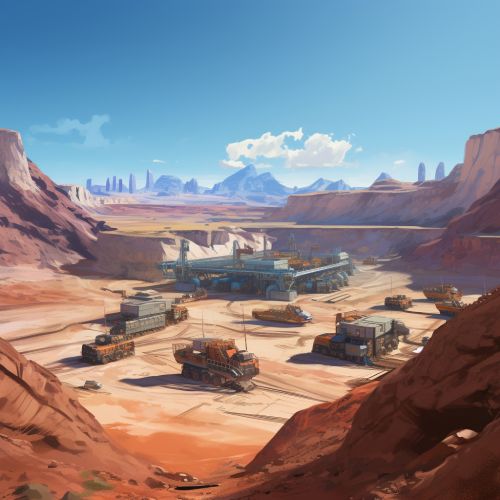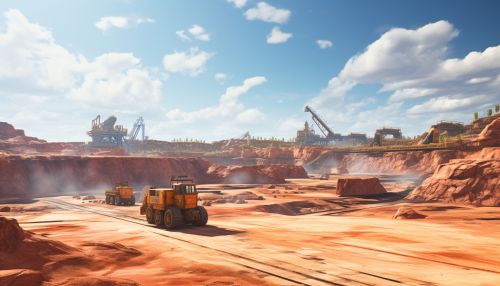Mining
Overview
Mining is the extraction of valuable minerals or other geological materials from the Earth, usually from an ore body, lode, vein, seam, reef, or placer deposit. These deposits form a mineralized package that is of economic interest to the miner. Ores recovered by mining include metals, coal, oil shale, gemstones, limestone, chalk, dimension stone, rock salt, potash, gravel, and clay. Mining is required to obtain any material that cannot be grown through agricultural processes, or feasibly created artificially in a laboratory or factory. Mining in a wider sense includes extraction of any non-renewable resource such as petroleum, natural gas, or even water.


History
Mining as a human activity dates back to the Paleolithic period, with the earliest evidence of mining activity being the mining of flint in what is now the Ziftá region of Egypt. This early mining was quite primitive, and consisted largely of manual labor. As human societies developed, so too did their ability to mine for resources, and mining became a critical part of many early civilizations, such as the ancient Egyptians and Romans. The development of mining technology and techniques has continued throughout human history, with significant advancements being made in the Industrial Revolution and the modern era.
Techniques
There are four main mining methods: underground, open surface (pit), placer, and in-situ mining. Underground mines are more expensive and are often used to reach deeper deposits. Surface mines are typically used for more shallow and less valuable deposits. Placer mining is used for sifted deposits of valuable minerals found in riverbeds. In-situ mining, which is primarily used in mining uranium, involves dissolving the mineral resource in place and then processing it at the surface without moving rock from the ground.
Environmental Impact
Mining operations can have a significant impact on the environment, including loss of biodiversity, erosion, contamination of surface water, ground water, and soil. The environmental impact of mining can be reduced by the careful management of process chemicals and wastes, careful planning of mining operations, and the restoration of mined areas.
Safety
Safety has long been a concern in the mining business, especially in sub-surface mining. The Courrières mine disaster, Europe's worst mining accident, involved the death of 1,099 miners in Northern France on March 10, 1906. This disaster was surpassed only by the Benxihu Colliery accident in China on April 26, 1942, in which 1,549 miners died. In the years since these disasters, significant progress has been made in improving mining safety, through improved mining methods and the introduction of new safety legislation and practices.
Economic Impact
Mining has a significant economic impact in many areas, providing jobs and driving economic growth. In some areas, mining represents the most significant economic activity, and the health of the local economy is closely tied to the health of the mining industry. However, mining can also have negative economic impacts, particularly in areas where the mining industry is not well regulated or where the benefits of mining are not shared equitably among the local population.
Future of Mining
The future of mining is likely to be heavily influenced by technological advancements, particularly in the areas of automation and artificial intelligence. These technologies have the potential to significantly increase the efficiency and safety of mining operations, and to reduce the environmental impact of mining. However, they also raise important questions about the future of employment in the mining industry, and the potential social and economic impacts of increased automation.
